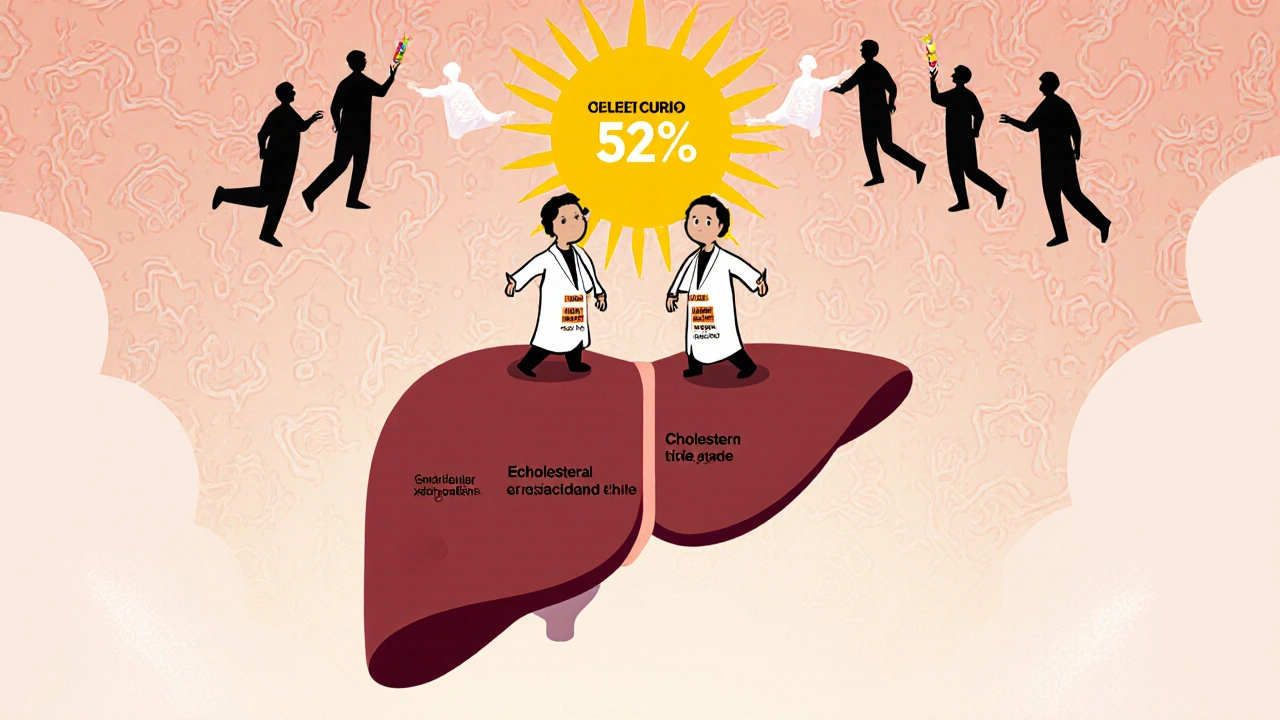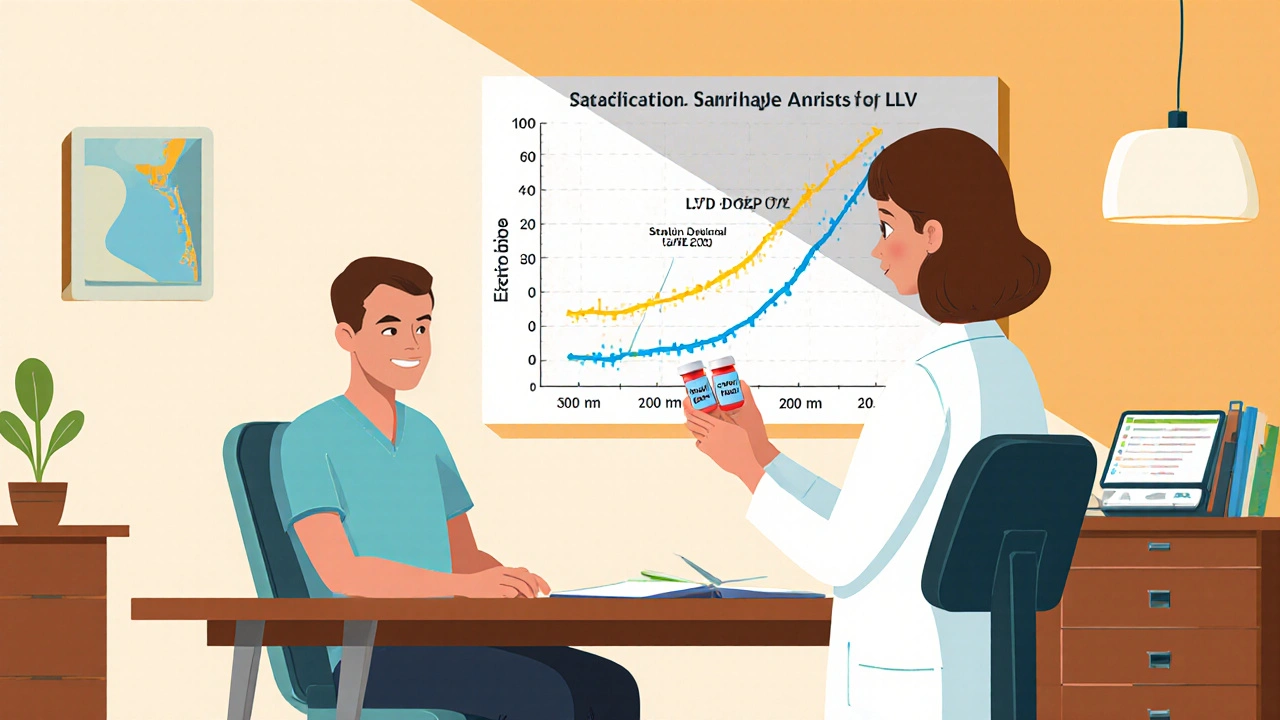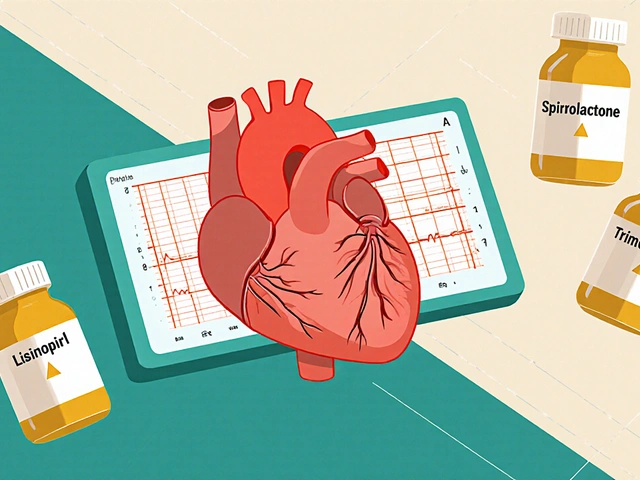Cholesterol Reduction Calculator
Calculate Your LDL Reduction
How this works: With combination therapy, you get a multiplicative effect on LDL reduction (not just additive). This means a lower statin dose combined with ezetimibe can often achieve the same or better results than high-dose statin alone with fewer side effects.
Side effect comparison: High-dose statins may increase muscle pain risk to 15%+, while combination therapy has minimal side effects (ezetimibe has only 5% muscle pain risk).
Your Results Explained
Why Higher Statin Doses Aren’t Always Better
You’ve probably heard that statins are the go-to for lowering cholesterol. But what if taking more of them doesn’t mean better results? Many people are put on high-dose statins like atorvastatin 80mg or rosuvastatin 20mg, hoping to crush their LDL numbers. But here’s the truth: doubling the statin dose only drops LDL by about 6% more. That’s not a big win-especially when you’re risking side effects like muscle pain, fatigue, or even liver issues. This is called the rule of six, and it’s backed by solid data from the Journal of the American College of Cardiology in 2023.
Let’s say you’re on atorvastatin 10mg and your LDL is 130. You bump up to 20mg. Your LDL might drop to 115. Sounds good, right? But if you go to 40mg, it only drops to 108. And at 80mg? Maybe 102. That’s barely any extra benefit-and your chance of muscle pain jumps from 5% to 15%. For many, that trade-off isn’t worth it.
What If You Could Get the Same Result with Less Statin?
Here’s the smarter approach: combine a lower statin dose with another cholesterol-lowering pill. This isn’t new, but it’s finally getting the attention it deserves. The most common combo? A moderate statin (like atorvastatin 20mg or rosuvastatin 10mg) plus ezetimibe (10mg). Together, they can slash LDL by 50-55%. That’s better than a high-dose statin alone-which maxes out around 50% reduction.
How does this work? It’s not simple addition. It’s multiplication. Think of it like this: if a statin lowers LDL by 40%, you’re left with 60% of your original cholesterol. Ezetimibe then blocks about 20% of what’s left. So 40% + (20% of 60%) = 52% total reduction. That’s the math behind it. And it’s why a 2025 meta-analysis of nearly 19,000 patients found that statin + ezetimibe lowered LDL by 23.7 mg/dL more than just doubling the statin dose.
Who Benefits Most From This Strategy?
This approach isn’t for everyone. It’s especially powerful for people in high-risk groups:
- Those who’ve had a heart attack or stroke
- People with diabetes and other heart risk factors
- Patients with familial hypercholesterolemia (inherited very high cholesterol)
- Anyone who can’t tolerate high-dose statins due to muscle pain or other side effects
For these folks, guidelines now recommend aiming for LDL below 55 mg/dL. That’s tough with statins alone. But with combination therapy, it’s doable. A 2024 study in the European Heart Journal showed that 78.5% of high-risk patients hit their target with statin + ezetimibe, compared to just 62.3% on statin alone. That’s a 16% jump in success rate.
And for those who can’t take statins at all? Bempedoic acid is a newer option. It works in the liver like statins but doesn’t enter muscle tissue-so muscle pain is much less common. Studies show pairing it with a low-dose statin gives the same LDL drop as a high-dose statin, but with 25% fewer muscle-related side effects.

Real Stories From the Clinic
A 68-year-old man in Cleveland came in after a heart attack. His LDL was 82 mg/dL on atorvastatin 80mg. He had muscle aches every week. His doctor didn’t want to stop the statin-it was keeping his LDL from soaring. So they switched him to atorvastatin 40mg plus ezetimibe 10mg. Within six weeks, his LDL dropped to 64. The muscle pain? Gone. He’s been on this combo for over a year now, no issues.
Another patient, a 54-year-old woman with diabetes and high cholesterol, tried three different statins. Each one gave her cramps. Her doctor switched her to rosuvastatin 10mg plus ezetimibe. Her LDL went from 148 to 76. She didn’t even notice the change in side effects. Now she takes one pill in the morning, one at night, and feels fine.
These aren’t rare cases. Surveys of U.S. cardiologists show that 30-40% of patients with heart disease need combination therapy to reach their goals. And for those who’ve tried and failed with statins alone, adherence skyrockets-85% stick with combination therapy after a year, versus just 50% who keep trying higher statin doses.
Cost vs. Benefit: Is It Worth It?
Yes, combination therapy costs more upfront. Ezetimibe runs about $300-$400 a year in the U.S. PCSK9 inhibitors? They’re $10,000+ annually. But here’s the flip side: every 1 mmol/L (39 mg/dL) drop in LDL-no matter how you get it-cuts your risk of heart attack, stroke, or death by 22%. That’s from decades of research, including the landmark IMPROVE-IT trial.
For high-risk patients, combination therapy isn’t just cheaper than PCSK9 inhibitors-it’s cheaper than having a second heart attack. One study found that if you lower LDL by 30% or more in someone with heart disease, the cost of the drugs is offset by avoided hospitalizations within two years.
Insurance can be a hurdle. Many require prior authorization for ezetimibe or bempedoic acid. That can delay treatment by 7-14 days. But if your doctor explains the risk of not acting-especially after a heart event-many insurers will approve it quickly.

Why Isn’t Everyone Doing This?
Because old habits die hard. Most guidelines still say: start with high-dose statin. If that doesn’t work, add something else. But the data now shows that starting with a combo gets patients to target faster and with fewer side effects. The European Atherosclerosis Society now says: for very high-risk patients, start with moderate statin + ezetimibe. That’s a big shift.
Primary care doctors, though, are slower to change. A 2023 study in JAMA Internal Medicine found only 25% of eligible patients got combination therapy at first visit. Why? Lack of training. Many weren’t taught the multiplicative math behind it. Or they’re worried about insurance. Or they think, “statins work, so why complicate it?”
The solution? Education. Tools from the National Lipid Association help doctors calculate expected LDL drops. And the American College of Cardiology now has a clear decision pathway for statin intolerance. But change takes time.
What’s Next? The Future of Cholesterol Treatment
By 2025, we’ll likely see major updates to guidelines worldwide. Leaked drafts of the new European guidelines suggest a Category I recommendation-meaning the strongest possible endorsement-for starting with moderate statin + ezetimibe in very high-risk patients. That’s huge.
And the market is catching up. Combination prescriptions are growing at 8.7% a year. Statin-only prescriptions? Only 2.3%. Ezetimibe sales have jumped 35% since 2020, mostly because generics are cheap and proven.
PCSK9 inhibitors still have a role-for people who need even more LDL reduction, like those with familial hypercholesterolemia who haven’t reached target. But for most, statin + ezetimibe is the sweet spot: effective, safe, and affordable.
What You Should Do
If you’re on a high-dose statin and still not at your LDL goal-or if you’re having side effects-talk to your doctor. Ask:
- Could a lower statin dose plus ezetimibe work better for me?
- What’s my current LDL? What’s my target?
- Have you considered bempedoic acid if I can’t tolerate statins?
Don’t assume more statin = better. The science says otherwise. The goal isn’t to take the biggest pill possible. It’s to get your LDL down safely-and stay alive longer.
Can I just take ezetimibe without a statin?
Ezetimibe alone lowers LDL by about 15-20%, which is less than even a low-dose statin. It’s not strong enough as a standalone for most high-risk patients. But for people who truly can’t take any statin-even the lowest dose-it’s still better than nothing. Your doctor may combine it with bempedoic acid or a newer drug like inclisiran if needed.
Does combination therapy reduce heart attacks?
Yes. The IMPROVE-IT trial showed that adding ezetimibe to simvastatin reduced heart attacks, strokes, and heart-related deaths by 24% over seven years compared to statin alone. That’s not just about lowering numbers-it’s about saving lives. The same holds true for PCSK9 inhibitors, which cut events by 15% in FOURIER.
Are there any downsides to combining drugs?
The main downside is cost and complexity. Taking two pills instead of one can be harder to remember, though many are now combined into one tablet. Insurance coverage can be tricky. But side effects are generally low-ezetimibe is very well tolerated, and bempedoic acid causes fewer muscle issues than statins. The real risk is doing nothing or staying on a high-dose statin that causes pain and doesn’t work well enough.
How long does it take to see results?
LDL levels usually drop within 2-4 weeks of starting combination therapy. Your doctor will likely check your blood in 6-8 weeks to see how much it changed. Most patients hit their target within 3 months. That’s faster than waiting to increase statin dose and hoping for more effect.
Is this approach right for someone with only high cholesterol and no heart disease?
For low-risk people with just high cholesterol and no other heart disease, high-dose statins are still the first choice. Combination therapy is usually reserved for those at very high risk-like those with diabetes, smoking, high blood pressure, or a family history of early heart disease. For them, the benefits outweigh the costs. But for healthy people with mildly elevated LDL, lifestyle changes and a low-dose statin are usually enough.







Jim Oliver
10 November 2025 - 10:27 AM
Let me get this straight: you’re telling me we’ve been overprescribing 80mg statins like they’re candy, and the real answer is a $300/year combo pill? Shocking. Next you’ll say aspirin cures cancer. The rule of six isn’t new-it’s been in textbooks since 2015. Why are we still having this conversation in 2025?
William Priest
11 November 2025 - 08:51 AM
ok so statins are overhyped? ezetimibe is the real MVP? lol i read this whole thing and now i feel like my doc is a dinosaur. also i dont even know what ezetimibe is but i’m gonna ask for it tomorrow. also my cholesterol is fine but i wanna feel smart.
Ryan Masuga
12 November 2025 - 09:00 AM
This is actually really encouraging. I’ve been on 40mg atorvastatin for 3 years and still get that weird muscle fatigue. I didn’t know a lower dose + ezetimibe could work better. I’m going to bring this up at my next appointment. Thanks for laying it out so clearly-it’s not every day you get science that actually makes sense.
Jennifer Bedrosian
13 November 2025 - 00:45 AM
OMG I’m so glad someone finally said this. My doc kept pushing me to 80mg and I was like NOPE my legs feel like lead. Then I switched to 20mg + ezetimibe and I haven’t felt this good in years. Also my cat started purring more when I’m home. Coincidence? I think not. #CholesterolWin
Lashonda Rene
13 November 2025 - 16:21 PM
I just want to say that I’ve been reading this whole thing and I’m really touched by how many people are suffering from side effects and how hard it is to get doctors to listen. I have a cousin who had a heart attack at 49 and they just kept upping his statin dose until he couldn’t even walk to the mailbox. Then they tried the combo and he’s back to gardening. It’s not just about numbers-it’s about being able to live your life without pain. I hope more people hear this.
Andy Slack
13 November 2025 - 20:25 PM
So let me get this right: less statin + one other pill = better results + fewer side effects? That’s like getting a Tesla with half the battery. Why isn’t this the default? I’m telling my whole family about this. This is the kind of medical wisdom we need more of.
Rashmi Mohapatra
15 November 2025 - 10:04 AM
Americans always think more medicine is better. In India we know: one pill is enough if it works. Why do you need two? And why is everyone so shocked? We’ve been doing this for decades. Also, your doctors are lazy. They don’t want to think.
Abigail Chrisma
15 November 2025 - 22:42 PM
As someone who’s worked with patients from all backgrounds, I’ve seen how stigma around medication can stop people from asking questions. This post doesn’t just explain science-it gives people permission to push back. That’s powerful. Thank you for writing this with such clarity and compassion.
Ankit Yadav
17 November 2025 - 20:02 PM
Good post. But I think we need to talk about access. In rural India, ezetimibe is not available in most clinics. Even if it’s better, it doesn’t help if you can’t get it. We need global guidelines that include affordability-not just science.
Meghan Rose
18 November 2025 - 05:05 AM
Wait so you’re saying my doctor has been wrong for the last 5 years? That’s kinda terrifying. I’ve been on 80mg for 4 years and I’m fine except for the constant muscle cramps and the fact that I can’t sleep. Should I just stop? What if I die? What if I’m the one who didn’t listen?
Steve Phillips
18 November 2025 - 13:19 PM
Oh my GOD. I’ve been screaming this from the rooftops since 2021. Statin worship is a cult. The pharmaceutical industry? They make BILLIONS on high-dose pills. And now we’re supposed to believe that doubling the dose gives you a 6% bump? That’s not science-that’s corporate math. EZETIMIBE IS THE REAL HERO. I’M WRITING A SONG ABOUT IT.
Rachel Puno
20 November 2025 - 10:24 AM
I’m a nurse and I see this every day. Patients are scared to speak up. They think their doctor knows best. But when you give them the facts-like the 23.7 mg/dL difference from that 2025 meta-analysis-they light up. This post is a gift. Share it. Print it. Hand it to your doctor.
Clyde Verdin Jr
21 November 2025 - 16:54 PM
Wow. Another ‘breakthrough’ that’s been around since 2017. The real story? Doctors are too lazy to read journals. And now we’re supposed to be impressed that someone wrote a blog post summarizing what’s already in the guidelines? Wake up. This isn’t innovation-it’s overdue common sense.
Key Davis
22 November 2025 - 23:05 PM
While the clinical evidence presented is compelling and aligns with recent international guidelines, the dissemination of such information requires careful contextualization. Many primary care providers operate under systemic constraints, including time limitations and fragmented electronic health record systems, which impede the adoption of nuanced therapeutic strategies. The solution lies not in criticism, but in structured decision-support tools integrated into clinical workflows.
Cris Ceceris
24 November 2025 - 00:30 AM
I keep thinking about how we treat our bodies like machines you just crank up with more fuel. But maybe it’s not about more-it’s about balance. Like how a plant doesn’t need more sun, just the right kind. This combo approach feels… gentler. Like medicine finally started listening. I wonder how many other things we’ve been doing wrong because we thought bigger meant better.